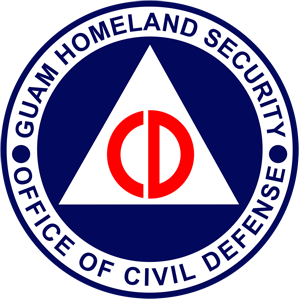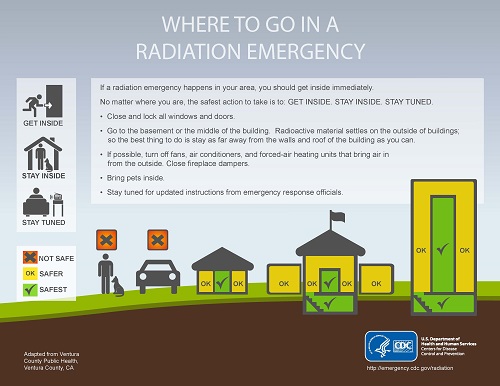Nuclear Explosion and Radiation Emergencies
Nuclear explosions can cause significant damage and casualties from blast, heat, and radiation but you can keep your family safe by knowing what to do and being prepared if it occurs.
A nuclear weapon is a device that uses a nuclear reaction to create an explosion.
Nuclear devices range from a small portable device carried by an individual to a weapon carried by a missile.
A nuclear explosion may occur with or without a few minutes warning.
Fallout is the most dangerous in the first few hours after the detonation when it is giving off the highest levels of radiation. It takes time for fallout to arrive back to ground level, often more than 15 minutes for areas outside of the immediate blast damage zones. This is enough time for you to be able to prevent significant radiation exposure by following these simple steps: GET INSIDE, STAY INSIDE, STAY TUNED.
GET INSIDE
- Get inside the nearest building to avoid radiation. Brick or concrete are best.
- Remove contaminated clothing and wipe off or wash unprotected skin if you were outside after the fallout arrived.
- Go to the basement or middle of the building. Stay away from the outer walls and roof.
STAY INSIDE
- Stay inside for 24 hours unless local authorities provide other instructions.
- Family should stay where they are inside. Reunite later to avoid exposure to dangerous radiation.
- Keep your pets inside.
STAY TUNED
- Tune into any media available for official information such as when it is safe to exit and where you should go.
- Battery operated and hand crank radios will function after a nuclear detonation.
- Cell phone, text messaging, television, and internet services may be disrupted or unavailable.
How to Stay Safe in the Event of a Nuclear Explosion
What to do NOW: Prepare
- Identify shelter locations. Identify the best shelter location near where you spend a lot of time, such as home, work, and school. The best locations are underground and in the middle of larger buildings.
- While commuting, identify appropriate shelters to seek in the event of a detonation.
- Outdoor areas, vehicles, mobile homes do NOT provide adequate shelter. Look for basements or the center of large multistory buildings.
- Make sure you have an Emergency Supply Kit for places you frequent and might have to stay for 24 hours. It should include bottled water, packaged foods, emergency medicines, a hand-crank or battery-powered radio to get information in case power is out, a flashlight, and extra batteries for essential items. If possible, store supplies for three or more days.
What to do DURING: Survive
- If warned of an imminent attack, immediately get inside the nearest concrete building and move away from windows. This will help provide protection from the blast, heat, and radiation of the detonation.
- Find the nearest building, preferably built of brick or concrete, and go inside to avoid any radioactive material outside.
- Stay where you are, even if you are separated from your family. Inside is the safest place for all people in the impacted area. It can save your life.
- Expect to stay inside for at least 24 hours unless otherwise told by authorities.
If Caught Outside
- Do not look at the flash or fireball – It can blind you.
- Take cover behind anything that might offer protection.
- Lie flat on the ground and cover your head. If the explosion is some distance away, it could take 30 seconds or more for the blast wave to hit.
- Be inside before the fallout arrives. The highest outdoor radiation levels from fallout occur immediately after the fallout arrives and then decrease with time.
- Take shelter as soon as you can, even if you are many miles from ground zero where the attack occurred – radioactive fallout can be carried by winds for miles. Remember the three protective factors: Distance, Shielding and Time.
What to do after: Be Safe
- If you were outside during or after the blast, get clean as soon as possible, to remove radioactive material that may have settled on your body.
- Remove your clothing to keep radioactive material from spreading. Removing the outer layer of clothing can remove up to 90% of radioactive material.
- If practical, place your contaminated clothing in a plastic bag and seal or tie the bag. Place the bag as far away as possible from humans and animals so that the radiation it gives off does not affect others.
- When possible, take a shower with lots of soap and water to help remove radioactive contamination. Do not scrub or scratch the skin.
- Wash your hair with shampoo, or soap and water. Do not use conditioner in your hair because it will bind radioactive material to your hair.
- Gently blow your nose and wipe your eyelids and eyelashes with a clean wet cloth. Gently wipe your ears.
- If you cannot shower, use a wipe or clean wet cloth to wipe your skin that was not covered by clothing.
- Clean any pets that were outside after the fallout arrived. Gently brush your pet’s coat to remove any fallout particles and wash your pet with soap and water, if available.
- It is safe to eat or drink packaged food items or items that were inside a building. Do not consume food or liquids that were outdoors uncovered and may be contaminated by fallout. Do not drink water from tap sources.
- If you are sick or injured, listen for instructions on how and where to get medical attention when authorities tell you it is safe to exit.
Hazards related to nuclear explosions
- BRIGHT FLASH can cause temporary blindness for less than a minute.
- BLAST WAVE can cause death, injury, and damage to structures several miles out from the blast.
- RADIATION can damage cells of the body. Large exposures can cause radiation sickness.
- FIRE AND HEAT can cause death, burn injuries, and damage to structures several miles out.
- ELECTROMAGNETIC PULSE (EMP) can damage electrical power equipment and electronics several miles out from the detonation and cause temporary disruptions further out.
- FALLOUT is radioactive, visible dirt and debris raining down from several miles up that can cause sickness to those who are outside
For more information on how you can prepare for a nuclear explosion, visit https://www.ready.gov/nuclear-explosion and https://emergency.cdc.gov/radiation/index.asp.
Hazardous Materials (HazMat)
Hazardous materials come in the form of explosives, flammable and combustible substances, poisons and radioactive materials. Hazards can occur during production, storage, transportation, use or disposal. You and your community are at risk if a chemical is used unsafely or released in harmful amounts into the environment where you live, work or play.
To learn more visit, https://www.ready.gov/hazardous-materials-incidents.
Weapons of Mass Destruction (WMD)
The United States faces a rising danger from terrorists and rogue states seeking to use weapons of mass destruction. A weapon of mass destruction is a nuclear, radiological, chemical, biological, or other device that is intended to harm a large number of people. The Department of Homeland Security works every day to prevent terrorists and other threat actors from using these weapons to harm Americans.
To learn more, visit https://www.dhs.gov/topic/weapons-mass-destruction.
Radiological Dispersion Device (RDD)
An RDD combines a conventional explosive device – such as a bomb – with radioactive material. It is designed to scatter dangerous and sub-lethal amounts of radioactive material over a general area.
Such RDDs appeal to terrorists because they require limited technical knowledge to build and deploy compared to a nuclear device. The size of the affected area and the level of destruction caused by an RDD would depend on the sophistication and size of the conventional bomb and other factors. The area affected could be placed off-limits to the public for several months.
For more information on how you can prepare for an RDD event, visit https://www.ready.gov/radiological-dispersion-device.










